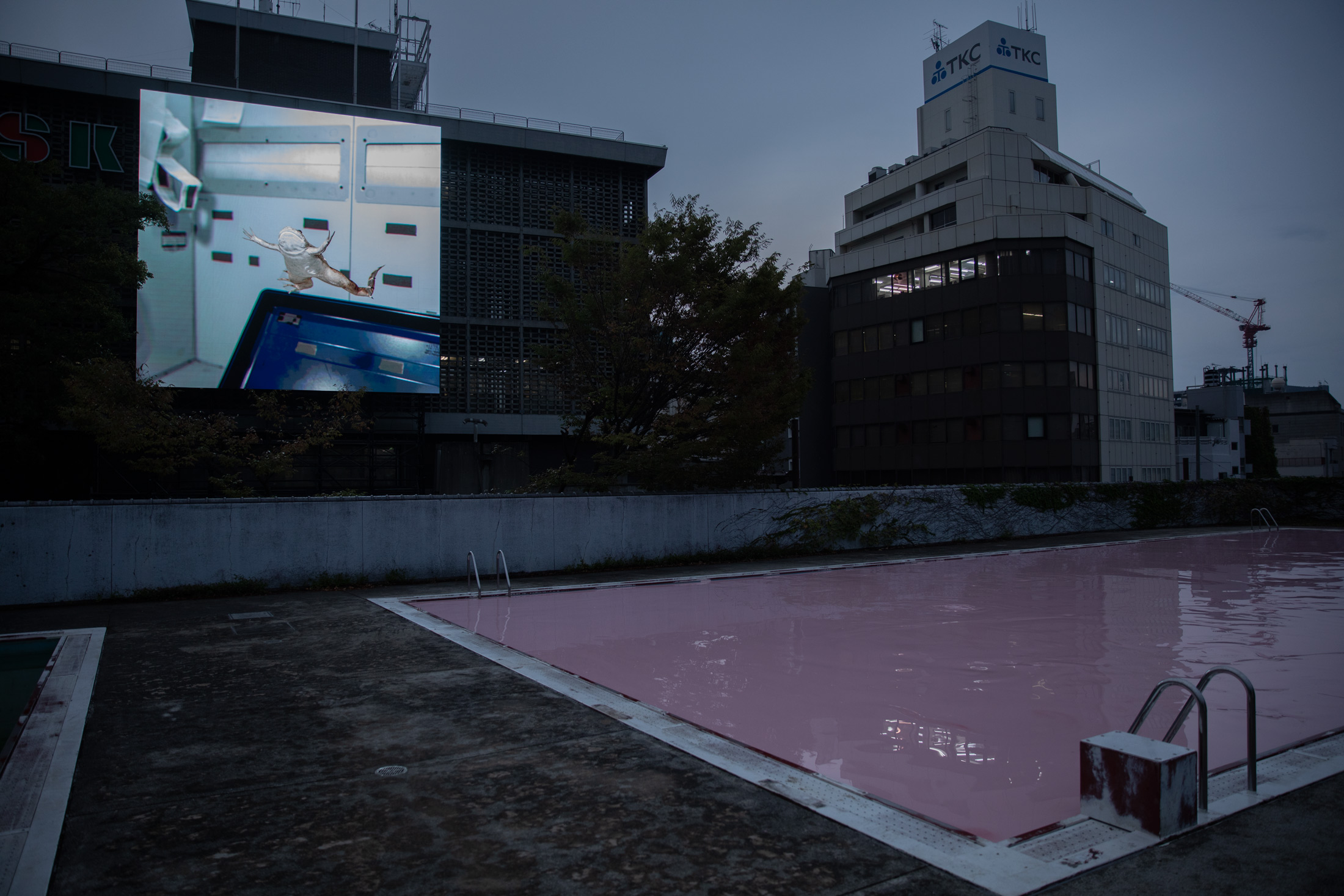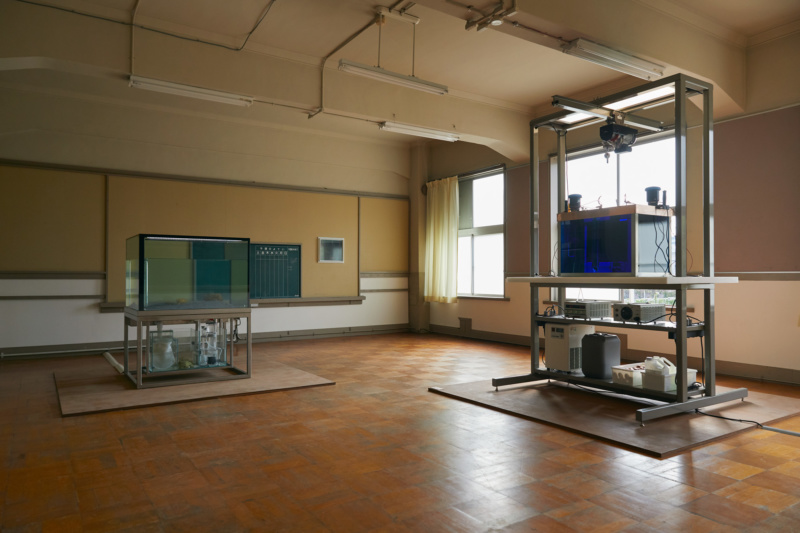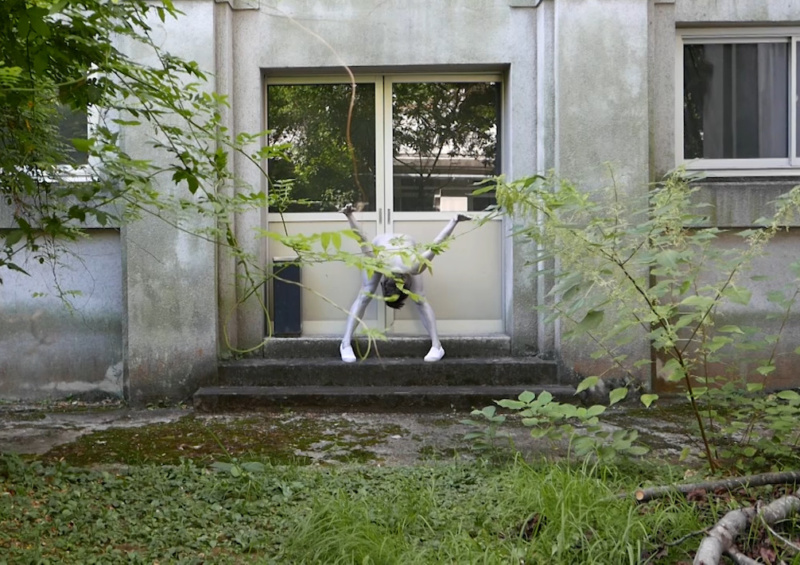
The snake has crawled through the mythical realm for ages, whether inching its way across the Garden of Eden or shapeshifting in India and Nepal, where the Ichchhadhari Nag, first created by Lord Krishna, was said to become human. One of its most insistent forms, though, is perhaps its simplest: the ouroboros of ancient Egyptian tombs forms itself into a ring, the snake swallowing its own tail. Utilized in alchemy, medicinal healing and the sealing of a pharaoh’s tomb, the creature indulges in its duplicity.
The serpent, then, is a fitting emblem for “IF THE SNAKE,” the second Okayama Art Summit triennial, taking place throughout the city this fall. French artist Pierre Huyghe is this second edition’s artistic director and has brought a concise network of artists to inhabit, fill, engineer or transform Okayama’s stately castle, museums and plazas for the season. Most of the works in the exhibition are paired up, with some couples working in causal relation, one causing another to react, and other duos existing more harmoniously, in conversation with each other. All of the nodes in the network come together to form a sort of analog (though occasionally digitally connected) internet of things and states. Fabien Giraud and Raphaël Siboni take over the interior of the former Uchisange Elementary School to display a 3,000-year-long narrative arc of large-scale destruction, bringing us to the year 4936. The first several rooms contain heavily constructed, large sculptures made by deepfake artificial intelligence, containing wooden horses, industrial lights and plaster-cast objects. Aged, broken down, dusty from their own combustions, they’ve fulfilled their complete life cycle in the same spot. Past creaking stairs and plastic tarps, the installation continues with films intercutting footage of President Nixon addressing the nation on network television with actors reading into microphones in these same rooms providing the only means of gaining some insight into this post-apocalyptic space.

At the very end of the hallway, the exhibition culminates with another collaboration, Not yet titled by Matthew Barney and Pierre Huyghe, in orderly and sunlit classrooms. Clinical tanks filled with various lucid, gemstone-colored liquids host Barney’s Cathode in Refugium, a series of chemically treated and highly reactive, metal plates colored over by tie-dyed rainbow gradients, with thin transparent tubes snaking in and out of the vessels like artificial arteries. The fact that this room was spared from the destructive force that ate away at the rest of the massive building offers little assurance; its door opening onto the school’s courtyard also might offer an alternative plot, where a laboratory experiment gone awry offered safety in its immediate vicinity but ruin right outside its own door.
The heart of “IF THE SNAKE” is located within the neighborhood of Uchisange, and all of the veins of the exhibition flow into it. Pamela Rosenkranz’s nauseating Skin Pool (Oromom), a roiling, bubbling rooftop swimming pool filled with what looks like Pepto Bismol, offers a sickly perch to take in John Gerrard’s X. laevis (Spacelab), a film following a frog’s slow-motion airborne journey through a grayed, airtight laboratory in zero gravity. It plays on a screen that takes up most of the facade of the high-rise RSK Sanyo Broadcasting Building across the street.
Sean Raspet’s radiant, sweet violet Ipomoea indica (morning glory): IRBIi Light Blue x IRBIi Silver Blue flowers grow tangled on the vine over the fence bordering the terrace. The strain is similar to the white morning glory plants that every young Japanese student learns to grow and cultivate in such an elementary school; only these have been cross-pollinated and developed through gamma radiation mutation to adorn this place. While the pink water splashes and the frog spins in mid-air, Tino Seghal’s untitled choreography is performed on the same platform: a loose formation of actors moving, posing and talking aimlessly while drifting around the open space and the stairs leading up to it. Thrown in and out of weightless, spontaneous formations, they seem to be alone in their conversations, talking past one another, overlooking each other and their surroundings.
Around the side of the main building, Tarek Atoui’s sound installation Glitter Beats and Wild Synths incorporates improvised materials into its precise choreography. Taking over the school’s massive gymnasium, his kinetic instruments form an in-situ symphony: driftwood, rotators, IVs filled with fluids and fans laid out on the floor in careful arrangements become percussive instruments that turn on with a wisp or a drop. At the Tenjinyama Cultural Plaza of Okayama Prefecture, Mika Tajima remotely activates New Humans, an oily, menacing recessed pool of undulating black liquid recessed in a neat rectangle in the floor. Her Force Touch (Corporis), a grid of gold-chromed jacuzzi jets inlaid within the nearby concrete wall “breathe” into a state of self-regulation, exhaling and forcing out air, causing a breeze with the same intensity of a fingertip gliding across a touchscreen.

As a parting gift of sorts, Sean Raspet collaborated with Integriculture Inc. for his Nonfood lunchbox of edible fuel for the future. Reacting to the looming crisis of natural resources, he created cheerfully colored meal kits with cookies, bananas with edible peels and rice balls as a sustainable alternative method of calorie consumption. We ate them on the walk over to the opulent Okayama Castle, where Lili Reynaud-Dewar screened her film I Want All Of The Above To Be The Sun (If the Snake) in a small wooden house on the grounds. Reynaud-Dewar became the exhibition’s most meta participant by being “IF THE SNAKE”‘s first visitor: she filmed her own reactions to visiting many of the other works on view, wearing only bright white canvas sneakers and a slick of silver body paint. Works by Étienne Chambaud, Paul Chan, Ian Cheng, Melissa Dubbin and Aaron S. Davidson, Glass Bead, Elizabeth Hénaff and Eva L’Hoest round out the show.
“IF THE SNAKE” comes back full circle, literally, on the grounds of the Former Uchisange Elementary School, where Rosenkranz presents a second work: a round wooden gazebo holds her Healer (Waters), an animatronic snake stretching itself several meters long, covered in black fabric and responding to Annlee, an anime character bought by Huyghe and Philippe Parreno in 1999, who is again on view in the film Two Minute Out of Time, screening inside the Hayashibara Museum of Art while actors perform Sehgal’s own Ann Lee in front of its faint projection. Moving at an almost invisible pace, this snake’s head may eventually coil to reach its own tail by its fangs, forming the symbol of the chaos surrounding our world: the ouroboros. Or perhaps it will end up taking on many other forms. Besides being known as an omen, the snake is also known for the ease with which it sheds its old skin.










 in your life?
in your life?

